

Problem Set 5.2
Problem 5.2.1. In the figure, ABCD is a rectangular swimming pool. You are in a well-marked point P in the pool, and you need to swim to the bank BC, then to CD, then to DA, and finally back to the original point P. You want to minimize your total swimming distance around the path from P and back to P. The figure suggests how to accomplish this goal and justify the path PQST is the shortest. Open GSP file if you need it.
a. Describe how to construct the required path PQST
Construct reflection of P in BC.
Construct reflection of P' in CD
Construct reflection of P'' in AD
Construct P'''P to locate T on AD. Construct TP'' to locate S on CD. Construct SP' to locate Q.
Draw PQST.
b. Prove that Path PQST is shorter than any path from P to a point X on BC, then to a point Y on CD, then to a point Z on AD, and back to P.
In would be sufficient to prove this for PXST. This follows from the result of Problem 5.1.5.
c. If P''' is the image of P'' under reflection in line AD, prove that the intersection of lines PP''' and AD is the point T.
Since P''' is the reflection of P'' in AD, then by Problem 5.1.5, T is the point that would give a minimum path from P to P''. But P'' is the image of P' in CD and s would be the point on CD for the minimum path from T to P'. Finally P' is the reflection of P in BC and so Q would be the point on BC for the minimum path from S to Q to P.
PQ = P'Q,
P'S = P'Q + QS,
P'S = P''S,
P''S + ST = P''T,
P''T = P'''T,
and PT + TP''' = PP'''
So, PP''' = PT + TP'''
= PT + TP''
= PT + ST + P''S
= PT + ST + P'S
= PT + ST + QS + P'Q
= PT + ST + QS + PQ
Since PP''' is a straight line equal in length to PT + ST + QS + PQ then Q, S, and T are the reflection points desired.
d. Prove that PQST is a parallelogram.
From problem 5.1.6 part a we now that if a line is reflect two perpendicular surfaces, the line to the first surface and the line from the second surface are parallel. Therefore PQ is parallel to ST and QS is parallel to PG.
e. Suppose the sides of the rectangle ABCD have lengths a and b, where BC = a and CD = b and a > b. Make a graph of a coordinate system so that A is at the origin, AD is on the x-axis, and AB is on the y-axis. Prove that PQST is a rectangle if and only if P in the interior of the rectangle is at a distance a - b from the side AB or the side CD
If PQST is a rectangle, then each of the right triangles abutting a side of PQRS are isosceles right triangles. Let x and y be the lengths of the two different size triangles. Then x+y = b AND the vertical line through P cuts off a square from ABCD. So the distance of P from AB must be equal to a - b.
Conversely, if P is the distance a - b from AB, then a square is cut off, the triangles are isosceles, and PQST is a rectangle.
f. Using the coordinate system from Part e, let P be (x0, y0) and P be a - b units away from AB. If PQST is a rectangle, find the coordinates of Q, S, and T in terms of a, b, x0, and y0.P = (x0, y0)
Q = (a - y0, b)
S = (a, b - y0)
T =(x0 + y0, 0)
g. Show there is only one point in the interior of ABCD such that the Path PQST is a square. Where is that point?
Since PQST must be a rectangle, x0 = a - b. Now if PQST is a square, the PQ = QS and the four corner triangles are congruent. They also must be isosceles and hence y0 = b/2.
h. Suppose the swimming pool was in the form of a square. For which point P will PQST be a rectangle and for which points will it be a square. Justify. . . (Note typo in the text . . .)
We have a - b = 0 and so for PQST to be rectangular the point P would need to be along AB. To be a square P would need to be the midpoint of AB.
i. Prove that if P is at the distance a - b from side AB of the rectangle ABCD, and a line through P that is perpendicular to side AD is then drawn, the boundary of the shaded region is a square.
Yellow has height = b
Width = a - (a - b) = b
Therefore it is a square.
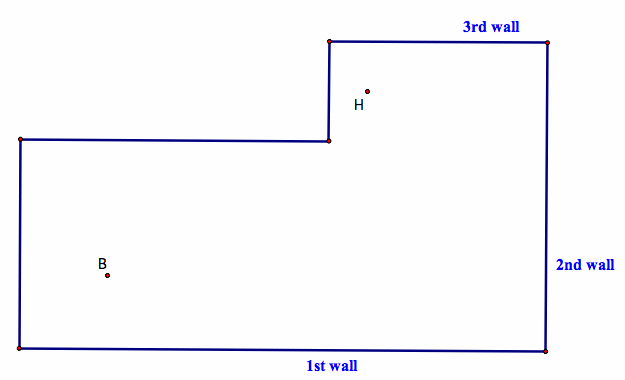 Problem 5.2.2 See GSP File from Jackie Ruff
Problem 5.2.2 See GSP File from Jackie Ruff
In the following figure, B is a ball and H is a hole on a miniature golf course. If you want the ball to bounce off all three walls, describe how to find the points P, Q, and S in the diagram. Assume that the angle of incidence equals the angle of reflection. Prove that the path B-P-Q-S-H is the shortest path connecting B with H through points on all three walls.
The solution is something like this:
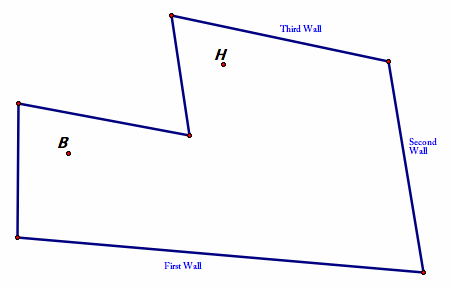 Did you assume the angles of the figure were right angles? If so, did you use that assumption anywhere in the solution?
Did you assume the angles of the figure were right angles? If so, did you use that assumption anywhere in the solution?
Try the same problem with this second design. Click Here for a GSP File to explore this design.
What about this one with the second wall an arc of a circle? It is on page 2 of the GSP File.
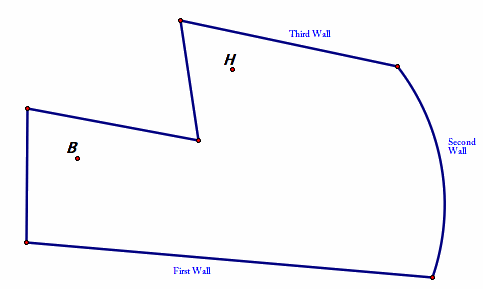
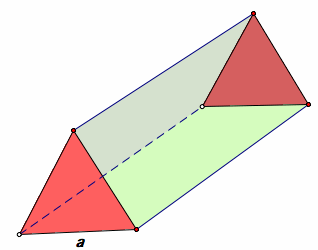 Problem 5.2.3 See the GSP file for a solution by Jackie Ruff
Problem 5.2.3 See the GSP file for a solution by Jackie Ruff
A kaleidoscope is in the shape of a prism and has a base in the form of an equilateral triangle whose side is a units. A beam of light is sent from a point P on the base of the prism at a 60 degree angle and is reflected from the mirrored sides, which are perpendicular to the base.
a) Construct the path that the beam of light follows.
b) Find, in terms of a, the length of the path that the beam of light follows from P to the moment it reaches P again.
Comment: I found the picture in the book a bit confusing so I have constructed the picture of a triangular prism with bases of equilateral triangles that is shown here. GSP file for these constructions.
Plan: We can consider path of the beam in the equilateral triangle making up the base; it would be the same for any cross-section of the prism. Here is a depiction of the first few steps.
Some of you will recognize this is a special case (Equilateral triangle) of the Bouncing Barney Problem from EMAT 6680 and Project Intermath. Just as with Bouncing Barney, there is a need to PROVE that the path will return Point P (Part a) and find the length of the journey. Will the length of the journey be the same for all points P on the side of the triangle?
Why do you suppose this problem was included in a problem set on using isometries in geometric constructions? Did you use isometries?

The "motivation" for major steps might be as follows. If a point Y on the circle is equidistant from P as a point X on the line is from P, then an isometry of HP would map X to Y or vice versa. We do not know the location of X or Y, so use HP to map the line to an image. The image will intersect the circle and each intersection is a Y point. Then a map of these points by HP will locate the X points on the line.
OR . . . we could use HP to map the circle to its image. The intersections would be the desired X points. Map these by HP to locate the Y points on the circle.
Make you own GSP file to see it done.
It is possible there is no solution. When?
Under what condition would there be only one solution if the image line of l is tangent to the circle. What is the relationship of the line, P, and the circle in that case?
Problem 5.2.5
ABCD is an a-unit by b-unit rectangular pool table. A ball positioned on side AB is hit toward side BC at a 45 degree angle. It bounces off as shown in the figure and returns to its original position P.
a. Find all values of a and b for which this phenomenon happens for every point on side AB. (Hint: Let P(0,h), where 0 < h < b, and calculate the coordinates of Q, S, T, U, V in terms of a, b, and h.
b. Suppose that P is at (k, h) in the interior of the rectangle. Use your result from (a) to find a necessary and sufficient condition (relating k, h, a, and b) such that a ball sent from a point at a 45 degree angle toward side BC will follow a similar path to the one shown in the figure and return to P.
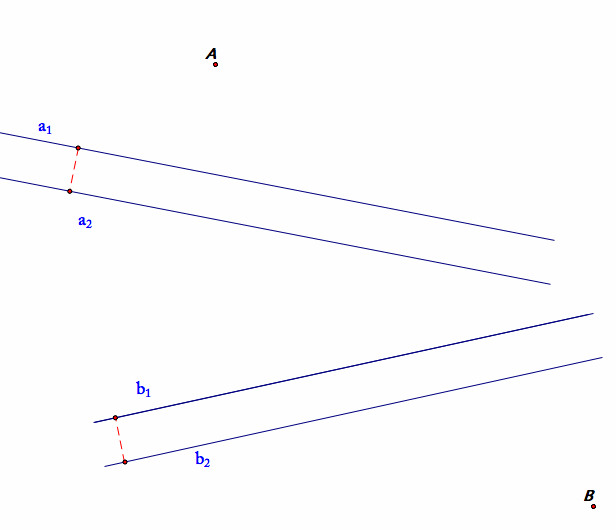 Problem 5.2.6
Problem 5.2.6
A highway connecting two cities A and B needs to be constructed such that part of the highway is on a bridge perpendicular to the banks a1 and a2 of a river and another part of the highway is on a second bridge perpendicular to the parallel banks b1 and b2 of a second river. Where should the bridges be built so the highway is a s short as possible? Describe the construction, construct the bridges and the highway, and prove that the highway you constructed is the shortest option.
There is a GSP file for you to use in your construction.
A GSP solution file by Mike Walliser.
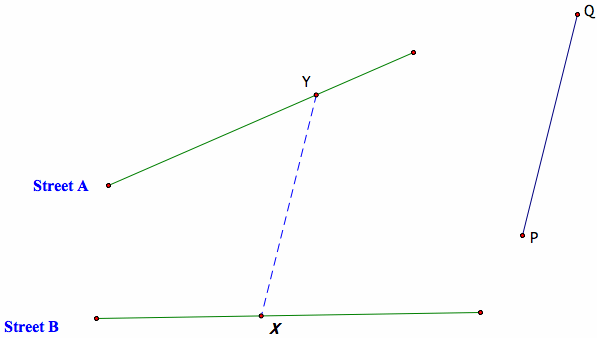 Problem 5.2.7 See GSP File for a solution from Jackie Ruff
Problem 5.2.7 See GSP File for a solution from Jackie Ruff
A new road connecting streets A and B needs to be constructed. The road, marked XY in the figure in the book, needs to be parallel to PQ and the same length as PQ. Construct the road. Motivate your construction and prove that it is correct.
Plan: Either a translation of Street A by the vector QP or a translation of Street B by the vector PQ will determine one of the two intersections. The inverse translation on the intersection so determined will locate the other.
Proof:
Because a translation is an isometry, every point on Street B is mapped to an image line parallel to Street B. The intersection of the image line and Street A is point Y. Since Y is an image point of some preimage on Street B, the inverse translation will map Y to its preimage X. As Y is mapped to X by a translation determined by PQ, the segment XY is therefore parallel to PQ by the definition of a translation.
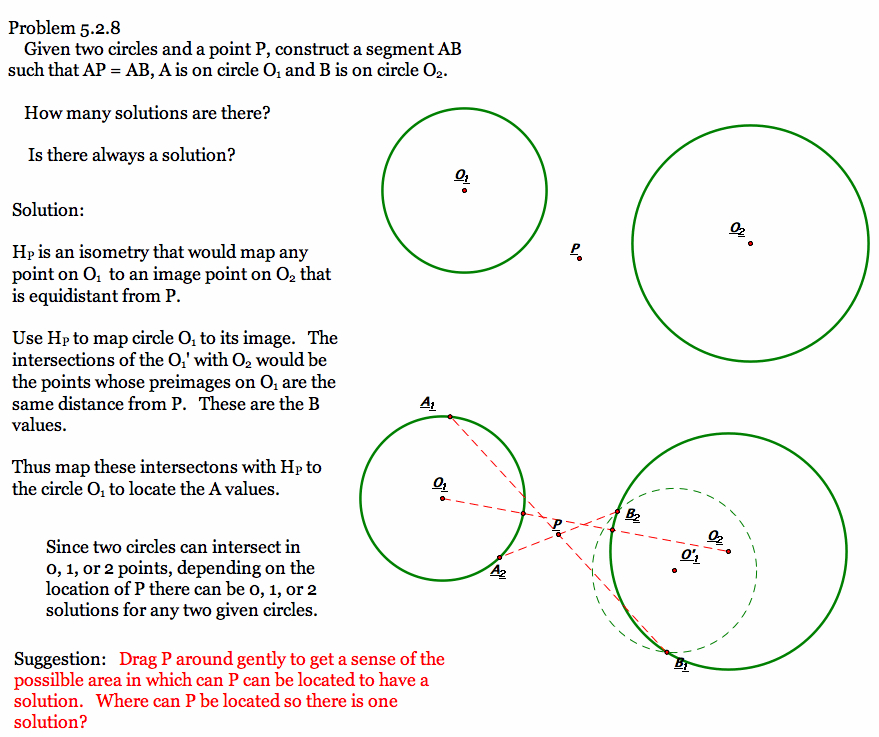
We could also have a case where this procedure generates an infinite number of solutions -- if the two circles had the same radius and P was located so the the image of O1 under HP was O2.
GIVEN TWO CIRCLES, HOW WOULD YOU DETERMINE THE REGION OVER WHICH P COULD BE LOCATED?
One suggestion: Work backwards. Let's take two given circles, locate A on one and B on the other one. Construct segment AB. Locate the midpoint P. Now animate A and B on their respective circles and trace the location of P. What do you expect? Do a GSP construction or try this one.
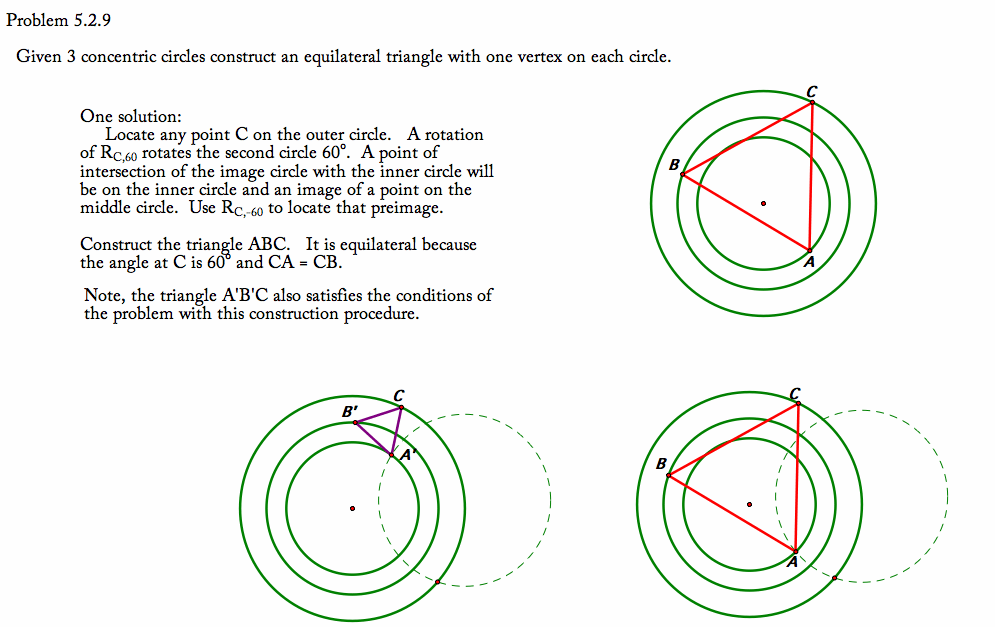
The construction may not be possible for certain spacing of the concentric circles. Can you determine when this would be the case? I think the configuration given in the textbook may be one for which the construction does not exist.
Give three concentric circles for which the construction is possible, there are at least 24 ways to do the construction. Two are shown here.
See the GSP File for discussion and more constructions on page 2.